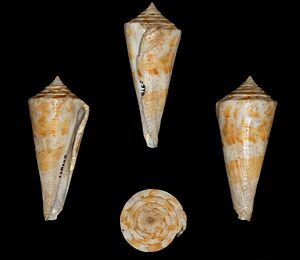Conus villepinii facts for kids
Quick facts for kids Conus villepinii |
|
|---|---|
 |
|
| Apertural and abapertural views of shell of Conus villepinii Fischer, P. & A.C. Bernardi, 1857 | |
 |
|
| Scientific classification | |
| Synonyms | |
|
Conus villepinii, common name Villepin's cone is a species of sea snail, a marine gastropod mollusk in the family Conidae, the cone snails and their allies.
Like all species within the genus Conus, these snails are predatory and venomous. They are capable of "stinging" humans, therefore live ones should be handled carefully or not at all.
Distribution
Locus typicus: Marie Galante de Guadeloupe, Lesser Antilles. The whereabouts of the original type specimen is unknown.
This variable marine species occurs from Florida to Southern Brasil and off Bermuda.
The species is better known from the Gulf of Mexico (trawler) sources. Immature specimens with purplish background colour, dredged off Barbados, may have been described as Conus hunti, Wils & Moolenbeek, 1979. The coloration of the living animal of these immature Barbados specimens of around 20 mm. in overall length is a dirty-white with flecks of black, and black fringing at the edge of the mantle and siphonal canal.
The type locality of Conus sanderi, Wils & Moolenbeek, 1979 is off St. James, west coast of Barbados West Indies, where type material was dredged at 155–180 metres depth by R.V. Martlet, operating from Bellairs Research Institute of McGill University at Holetown, Barbados. This species also known from as far south as Eastern Brasil.
Description
The maximum recorded shell length is 93 mm.
Habitat
Minimum recorded depth is 25 m. Maximum recorded depth is 475 m.
Cone shells looking very similar in appearance to the shell presented as the type illustration of C.villepinii have been dredged off West coast of Barbados, Lesser Antilles at depths around 85 fms/510 feet.

